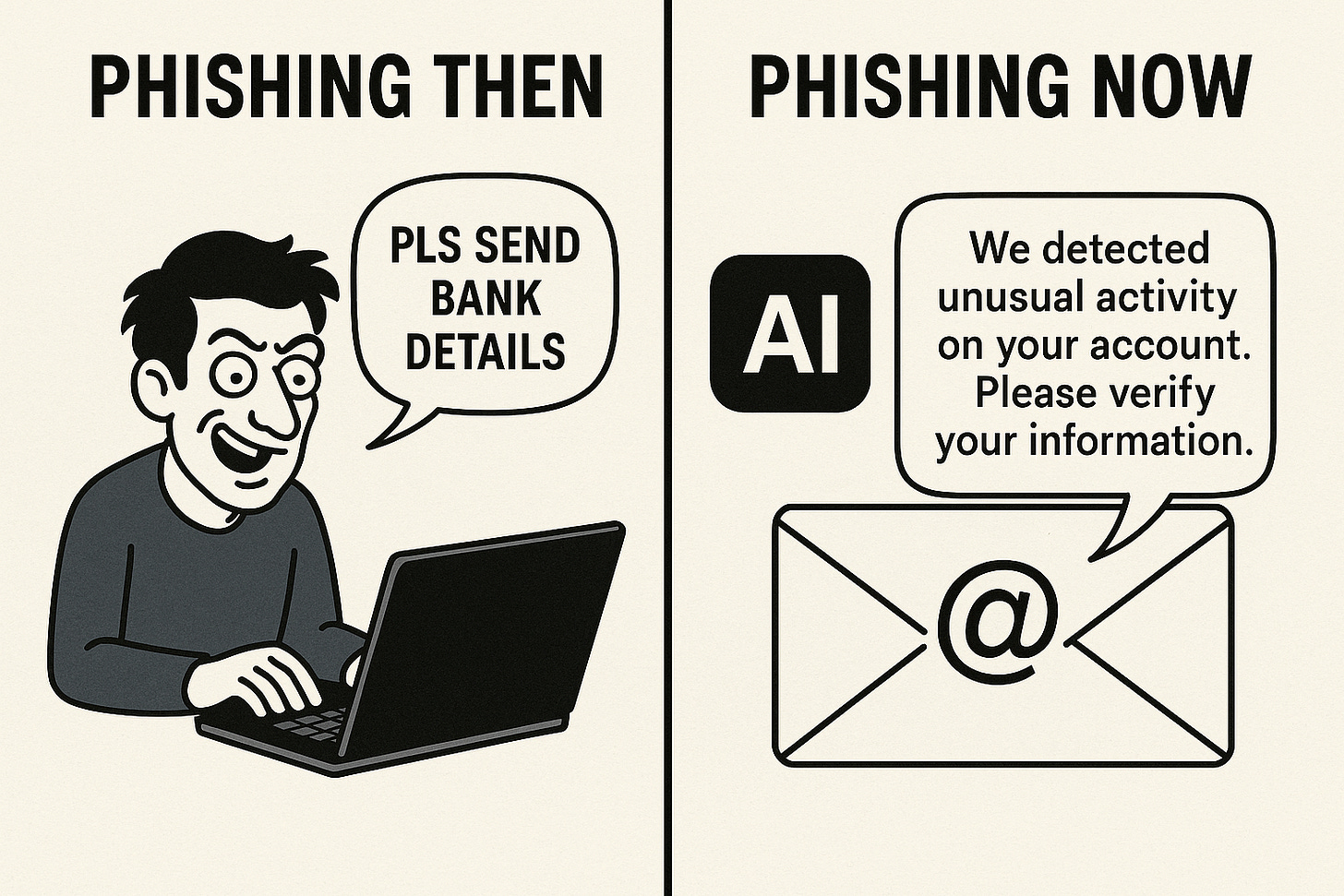The Scam Got Smarter. The Victim Didn’t.
Once upon a time, you could spot a phishing scam from a mile away. The English was broken, the story was bizarre, and the whole thing screamed “written by someone who just discovered email yesterday.”
“Beloved Sir, pls urgent send me monies.”
You’d laugh, delete it, and brag at the office coffee machine about how obvious it was.
But now? The scammer has a new best friend. And it’s not a Nigerian prince — it’s generative AI.
The Nigerian prince just hired Shakespeare.
The End of Funny Scams
Here’s the thing: AI doesn’t just fix typos. It polishes tone. It mimics professionalism. It can write an email that sounds exactly like your HR department, your boss, or your favorite vendor.
Instead of “pls send bank,” you now get:
“We’ve noticed unusual activity on your account. Please verify your credentials to prevent suspension.”
Same scam. Different suit. Suddenly, you’re not laughing.
And that’s the point: phishing stopped being funny. It started being effective.
Crime at the Speed of Copy-Paste
Phishing used to take work. A scammer had to research, craft, send. AI nukes that friction. One prompt and you’ve got a thousand variations, each tailored, each tested.
Want an email that sounds like your CEO asking for a wire transfer? Easy.
Need a fake invoice that looks like it came from Deloitte? Done.
Want something that flatters the recipient by referencing their conference talk? AI will even sprinkle in the applause.
It’s crime as a service, at SaaS speed.
Why Filters Don’t Stand a Chance
Your company’s spam filter is like TSA at the airport. It’s good at catching shampoo bottles and water jugs, but terrible at spotting the guy with the fake credentials and a charming smile.
Filters look for patterns: weird grammar, broken links, shady keywords. AI removes all those tells. Now the email looks like it belongs in your inbox.
Worse, attackers are smart enough to run their phishing drafts through the same open-source detection filters defenders use. By the time the email hits you, it’s pre-approved for delivery.
That’s like a burglar testing your alarm system before breaking in.
Spear-Phishing With Style
Old-school spear-phishing was deadly but tedious. Hackers had to stalk LinkedIn, scrape bios, mimic tone. AI does that instantly.
It doesn’t just send you a generic link. It crafts:
“Hi Sarah, loved your RSA talk on zero trust. We’re building a similar initiative and would love your thoughts on our approach. Draft attached — appreciate your input.”
That’s not a scam email. That’s flattery with a side of poison.
And you’re busy, proud of your RSA talk, and flattered someone noticed. That’s the hook — set with style.
When the Scam Writes Back
Here’s where it gets dystopian. AI isn’t just writing the first email anymore. It’s running the whole conversation.
You reply cautiously — “Can you clarify?” — expecting the scammer to fumble. Instead, you get a thoughtful, patient reply. Friendly tone. Correct grammar. A few reassuring emojis.
By the third exchange, you’re comfortable. And that’s when you click.
We’ve entered the era of phishing chatbots. The hook doesn’t just land — it reels you in, patiently.
The Economics of Evil
Phishing was already cheap. AI made it dirt-cheap.
Before: you needed a team, a decent command of English, and some hustle.
Now: you need a laptop, a free model, and ambition.
Underground markets are already offering “Phishing-as-a-Service.” Packages include 100 AI-crafted spear-phishing emails for $500. Need a fake helpdesk chatbot? $1,200 and it’s yours.
It’s not just cybercrime anymore. It’s productized. Bundled. Monetized. With customer service.
The dark web has better support than your internet provider.
The Human Weak Link
At the end of the day, though, the weak spot hasn’t changed. It’s not firewalls or filters. It’s us.
Humans don’t get hacked because the email is perfect. Humans get hacked because they’re tired, distracted, rushing to get out the door before Friday happy hour.
AI doesn’t exploit your inbox. It exploits your psychology.
And our psychology has always been the softest target in the stack.
Fighting Back Without Losing Our Minds
So how do you fight an enemy that writes like your boss, flatters like your best friend, and waits like a fisherman at dawn?
AI vs. AI.
You’re not going to out-guess it. You need defensive models that can flag subtle manipulations. Welcome to the arms race.Behavioral Analysis.
Don’t just judge the email — watch what happens after the click. Did the device start talking to a server in Moldova? That’s your clue.Kill Urgency.
Teach people that “Immediate Action Required” is hacker code for “Stop. Breathe. Verify.”Multi-Channel Verification.
Big decision by email? Call. Text. Slack. If the stakes are high, double-check outside the inbox.Normalize Skepticism.
Make it socially acceptable to say, “This looks weird.” No shame in asking twice. The shame is in wiring $3 million to a fake vendor.
The Hook Never Dies
Phishing thrived when it was sloppy. It thrives even more now that it’s perfect.
The truth is ugly but simple: phishing will never go away. Because it’s not about the tech. It’s about trust. And trust is the hardest vulnerability to patch.
AI just gave attackers a better pen, better grammar, and unlimited patience.
The hook writes itself now.
The only question left is whether we keep biting.
#Cybersecurity #AI #Phishing #DataSecurity #EnterpriseRisk #HumanFactor #AdversarialAI #TrustButVerify #FutureOfSecurity


